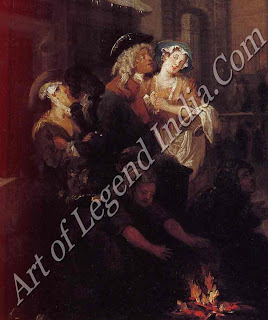 IN THE BACKGROUND
IN THE BACKGROUND
In
Hogarth's time, London was a dangerous and devouring city. Men lived in
conditions of squalour and misery, while fashionable society conveniently
turned a blind eye.
Hogarth
lived, worked and died in London and much of his best work, fashionable
painting as well as popular engraving, had London as its background. Only in
Industry and Idleness, however, did he present a picture of London as it
appeared to those outside the metropolis. By tracing the progress of two
contrasting Londoners; Francis Goodchild the industrious apprentice and Torn
Idle the ne'er-do-well, he illustrated the dual fascination this glittering and
yet frightening place exercised over the minds of people throughout the
country. London was the city of opportunity where a mere apprentice might
aspire to riches and honour far beyond the dreams of any village lad, but it
was also a dark and menacing place which swallowed up men and women and sucked
them into degradation and despair. Going to London was like embarking on some
terrible game of snakes and ladders, a game in which the constraining
certainties of country life, 'the short and simple annals of the poor', were
replaced by giddy ascents and plummeting falls.
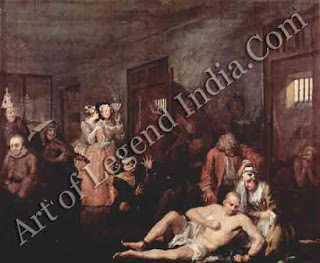 In part
the dangers were physical. Everyone developed a chronic cough when they first
came to London, a foreign visitor reported, because the air was polluted with
coal smoke. Country cottages might be unhealthy their floors were usually of damp
mud, causing arthritis and rheumatism but London tenements were much worse,
encouraging the spread of contagious disease and endangering life and limb by
their rickety condition. In London, Dr Johnson remarked, 'falling houses
thunder on your head'. Work might be better paid than in the country, but it
was often debilitating or disabling: London carpenters, Adam Smith observed,
seldom lasted more than eight years 'in their utmost vigour' because of the
effect their occupation had on their lungs.
In part
the dangers were physical. Everyone developed a chronic cough when they first
came to London, a foreign visitor reported, because the air was polluted with
coal smoke. Country cottages might be unhealthy their floors were usually of damp
mud, causing arthritis and rheumatism but London tenements were much worse,
encouraging the spread of contagious disease and endangering life and limb by
their rickety condition. In London, Dr Johnson remarked, 'falling houses
thunder on your head'. Work might be better paid than in the country, but it
was often debilitating or disabling: London carpenters, Adam Smith observed,
seldom lasted more than eight years 'in their utmost vigour' because of the
effect their occupation had on their lungs.
London's
overcrowding meant that lack of sanitation was more serious than in the
country. Although Peter Kahn, a visitor from Sweden, noted that Londoners kept
their night soil and sold it for manure, there were undoubtedly many whose
attitude to such matters was less commercial, more casual. Hogarth's picture of
a London night scene, in which a chamber pot is emptied over the head of a
passer-by, was not a mere fiction, It was a stinking city, the agricultural
writer Arthur Young concluded, in which men either died in destitution or lived
in dirt.
AN IRRESPONSIBLE CITY
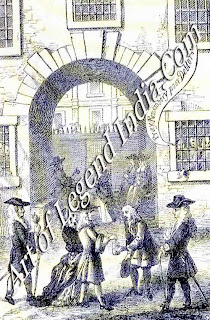 Young,
like the farmers for whom he wrote, saw London as something unnatural,
unwholesome, an excrescence on the country's otherwise healthy body politic.
Its physical dangers and hazards, great though they were, were as nothing
compared with the moral ones. 'The debauched life of its inhabitants,' he
wrote, 'occasions them to be idler than in the country. The very maxims and
principles upon which life is founded in great cities are the most powerful of
all enemies to common industry.' Above all, London was an irresponsible city, a
place where the rich had abandoned their obligations to keep the poor under
control. In the country every labouring man had a master who was responsible
for him and a parish organization which regulated his life from the cradle to
the grave. In London, however, there were thousands upon thousands of men,
women and children who were masterless and could not effectively be tied down
to any particular parish. They formed what men of substance spoke of
apprehensively as 'the mob'.
Young,
like the farmers for whom he wrote, saw London as something unnatural,
unwholesome, an excrescence on the country's otherwise healthy body politic.
Its physical dangers and hazards, great though they were, were as nothing
compared with the moral ones. 'The debauched life of its inhabitants,' he
wrote, 'occasions them to be idler than in the country. The very maxims and
principles upon which life is founded in great cities are the most powerful of
all enemies to common industry.' Above all, London was an irresponsible city, a
place where the rich had abandoned their obligations to keep the poor under
control. In the country every labouring man had a master who was responsible
for him and a parish organization which regulated his life from the cradle to
the grave. In London, however, there were thousands upon thousands of men,
women and children who were masterless and could not effectively be tied down
to any particular parish. They formed what men of substance spoke of
apprehensively as 'the mob'.
There
were in fact comparatively few episodes of mob rule in London during Hogarth's
lifetime, though after his death conditions grew worse, culminating in the
terrifying Gordon riots of June 1780. But it was certainly true that London
crowds showed scant respect for rank or authority. They mocked ostentation and
pretension mercilessly dandies and others dressed in the height of fashion
often found it necessary to wrap themselves in large black bags to avoid being
jeered at and they also mocked disabilities of all kinds.
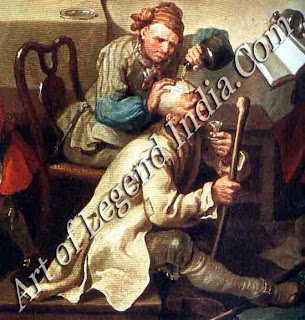 The
underlying trouble the real thing that gave London life its edge of insecurity
and unease was neither physical nor moral, but organizational. Law and order in
the country was the responsibility of parish constables and for the most part
it was within their powers. London, on the other hand, consisted of two cities
London itself to the east, Westminster to the west each run on quite different
lines. It was no accident that Hogarth's scenes of solid and secure town life
were set in the City of London itself, while his harlots and rakes and idle
apprentices tended to gravitate towards Drury Lane and the streets around it.
The
underlying trouble the real thing that gave London life its edge of insecurity
and unease was neither physical nor moral, but organizational. Law and order in
the country was the responsibility of parish constables and for the most part
it was within their powers. London, on the other hand, consisted of two cities
London itself to the east, Westminster to the west each run on quite different
lines. It was no accident that Hogarth's scenes of solid and secure town life
were set in the City of London itself, while his harlots and rakes and idle
apprentices tended to gravitate towards Drury Lane and the streets around it.
There,
according to a tract published in 1749, anyone taking 'a gentle walk' would
meet with men and women possessed by the Devil himself: 'Theft, Whoredom,
Homicide and Blasphemy peep out of the very windows of their souls; Lying
Perjury, Fraud, Impudence and Misery the only graces of their countenance. By
and by a Brandy Shop is going to be demolished because the master refuses to
bail some whore that's just arrested. . . A riot breaks out in another place, a
bawd's goods are seized on for rent. . . A cry of murder is heard about 20
yards further, a Mother or Father being under the bastinadoing of a dutiful son
or daughter. Pimps and pensioners to the hundred you see skulking from
bawdy-house to bawdy-house incessantly.' Other and more elegant publications,
such as Henry's List of Covent Garden Ladies and The Man of Pleasure's
Kalendar, put the emphasis on the satisfaction of whoring rather than on the
attendant disorders, but basically they told the same story. And when Boswell
took 'a monstrous big whore' into a tavern in 1763 and then refused to agree to
her terms, he quite expected that the result would be a riot. However, he
concluded somewhat smugly, 'I was on my guard, and got off pretty well'.
PAID INFORMERS
With no
police force and with inadequate parish resources the only way to catch and
convict criminals was by means of paid informers. The most notorious of these
was Jonathan Wild, the real life original of Peachum in The Beggar's Opera. He
first blackmailed other criminals, threatening to inform on them, and then when
they would no longer pay, he betrayed them to the authorities and took the
reward. He also bought stolen goods from thieves at cut prices and returned
them to their owners for a suitable consideration. It needed changes in the law
to get him caught and hanged in 1725; and for many years after that there were
still gangs that picked up victims, gulled them into stealing marked goods from
shopkeepers and collected the reward. Most of them got away with it, but when
one gang was unmasked in 1755, the leaders were stoned to death by the crowd.
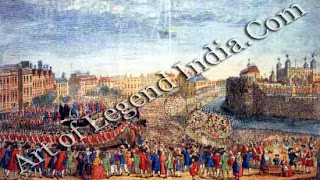 Other
informers, even perfectly innocent ones, were liable to suffer a similar fate.
Daniel Clark, in 1765, saw other weavers cut silk from looms and was forced to
testify to it in court when they were charged, with the result that he was
hounded for more than a year by the friends of the accused before being finally
thrown into a pond and stoned until his brains were beaten out. The pillory,
where the crowd crucified its victims, was the most enduring symbol of the
eagerness with which London's rulers handed over their responsibilities to the
savagery of the streets.
Other
informers, even perfectly innocent ones, were liable to suffer a similar fate.
Daniel Clark, in 1765, saw other weavers cut silk from looms and was forced to
testify to it in court when they were charged, with the result that he was
hounded for more than a year by the friends of the accused before being finally
thrown into a pond and stoned until his brains were beaten out. The pillory,
where the crowd crucified its victims, was the most enduring symbol of the
eagerness with which London's rulers handed over their responsibilities to the
savagery of the streets.
Towards
the middle of the century the Duke of Bedford's tenants in Bloomsbury asked him
to have an alley blocked up because it was used by local thugs and they were
therefore 'continually disturbed by the dismal cry of murder and other
disagreeable noises'. It did not occur to them to ask him to bring the thugs to
book. For the most part gentlemen and noblemen in London pursued their
pleasures without thinking that they were in any way responsible for the
underworld of violence and anarchy which those pleasures had called into being.
This, perhaps even more than Hogarth's attacks on connoisseurs and foppish
absurdities, was the true indictment of what passed for fashionable society in
18th-century London.
Writer
– Marshall Cavendish
 In part
the dangers were physical. Everyone developed a chronic cough when they first
came to London, a foreign visitor reported, because the air was polluted with
coal smoke. Country cottages might be unhealthy their floors were usually of damp
mud, causing arthritis and rheumatism but London tenements were much worse,
encouraging the spread of contagious disease and endangering life and limb by
their rickety condition. In London, Dr Johnson remarked, 'falling houses
thunder on your head'. Work might be better paid than in the country, but it
was often debilitating or disabling: London carpenters, Adam Smith observed,
seldom lasted more than eight years 'in their utmost vigour' because of the
effect their occupation had on their lungs.
In part
the dangers were physical. Everyone developed a chronic cough when they first
came to London, a foreign visitor reported, because the air was polluted with
coal smoke. Country cottages might be unhealthy their floors were usually of damp
mud, causing arthritis and rheumatism but London tenements were much worse,
encouraging the spread of contagious disease and endangering life and limb by
their rickety condition. In London, Dr Johnson remarked, 'falling houses
thunder on your head'. Work might be better paid than in the country, but it
was often debilitating or disabling: London carpenters, Adam Smith observed,
seldom lasted more than eight years 'in their utmost vigour' because of the
effect their occupation had on their lungs.  Young,
like the farmers for whom he wrote, saw London as something unnatural,
unwholesome, an excrescence on the country's otherwise healthy body politic.
Its physical dangers and hazards, great though they were, were as nothing
compared with the moral ones. 'The debauched life of its inhabitants,' he
wrote, 'occasions them to be idler than in the country. The very maxims and
principles upon which life is founded in great cities are the most powerful of
all enemies to common industry.' Above all, London was an irresponsible city, a
place where the rich had abandoned their obligations to keep the poor under
control. In the country every labouring man had a master who was responsible
for him and a parish organization which regulated his life from the cradle to
the grave. In London, however, there were thousands upon thousands of men,
women and children who were masterless and could not effectively be tied down
to any particular parish. They formed what men of substance spoke of
apprehensively as 'the mob'.
Young,
like the farmers for whom he wrote, saw London as something unnatural,
unwholesome, an excrescence on the country's otherwise healthy body politic.
Its physical dangers and hazards, great though they were, were as nothing
compared with the moral ones. 'The debauched life of its inhabitants,' he
wrote, 'occasions them to be idler than in the country. The very maxims and
principles upon which life is founded in great cities are the most powerful of
all enemies to common industry.' Above all, London was an irresponsible city, a
place where the rich had abandoned their obligations to keep the poor under
control. In the country every labouring man had a master who was responsible
for him and a parish organization which regulated his life from the cradle to
the grave. In London, however, there were thousands upon thousands of men,
women and children who were masterless and could not effectively be tied down
to any particular parish. They formed what men of substance spoke of
apprehensively as 'the mob'.  The
underlying trouble the real thing that gave London life its edge of insecurity
and unease was neither physical nor moral, but organizational. Law and order in
the country was the responsibility of parish constables and for the most part
it was within their powers. London, on the other hand, consisted of two cities
London itself to the east, Westminster to the west each run on quite different
lines. It was no accident that Hogarth's scenes of solid and secure town life
were set in the City of London itself, while his harlots and rakes and idle
apprentices tended to gravitate towards Drury Lane and the streets around it.
The
underlying trouble the real thing that gave London life its edge of insecurity
and unease was neither physical nor moral, but organizational. Law and order in
the country was the responsibility of parish constables and for the most part
it was within their powers. London, on the other hand, consisted of two cities
London itself to the east, Westminster to the west each run on quite different
lines. It was no accident that Hogarth's scenes of solid and secure town life
were set in the City of London itself, while his harlots and rakes and idle
apprentices tended to gravitate towards Drury Lane and the streets around it.  Other
informers, even perfectly innocent ones, were liable to suffer a similar fate.
Daniel Clark, in 1765, saw other weavers cut silk from looms and was forced to
testify to it in court when they were charged, with the result that he was
hounded for more than a year by the friends of the accused before being finally
thrown into a pond and stoned until his brains were beaten out. The pillory,
where the crowd crucified its victims, was the most enduring symbol of the
eagerness with which London's rulers handed over their responsibilities to the
savagery of the streets.
Other
informers, even perfectly innocent ones, were liable to suffer a similar fate.
Daniel Clark, in 1765, saw other weavers cut silk from looms and was forced to
testify to it in court when they were charged, with the result that he was
hounded for more than a year by the friends of the accused before being finally
thrown into a pond and stoned until his brains were beaten out. The pillory,
where the crowd crucified its victims, was the most enduring symbol of the
eagerness with which London's rulers handed over their responsibilities to the
savagery of the streets. 

.jpg)










Such a nice blog ,Thank you for sharing.-
It will may help you :-
Cheap beads